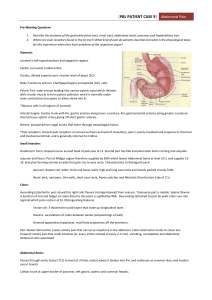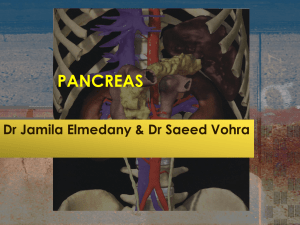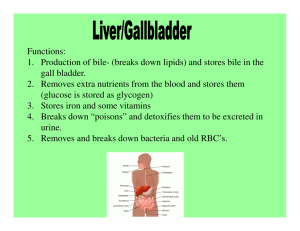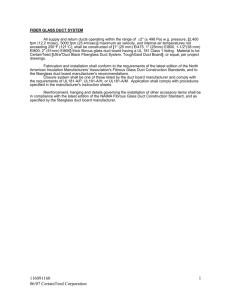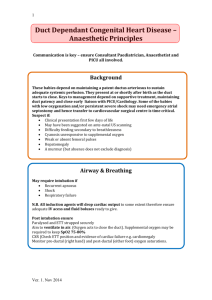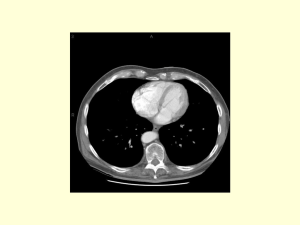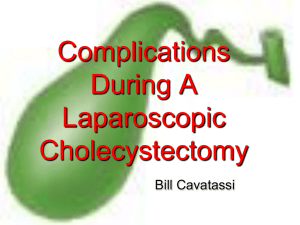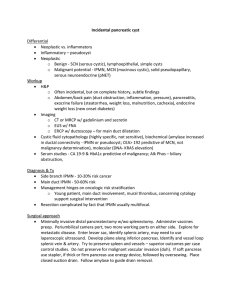03-Duodenum and Panc..
advertisement
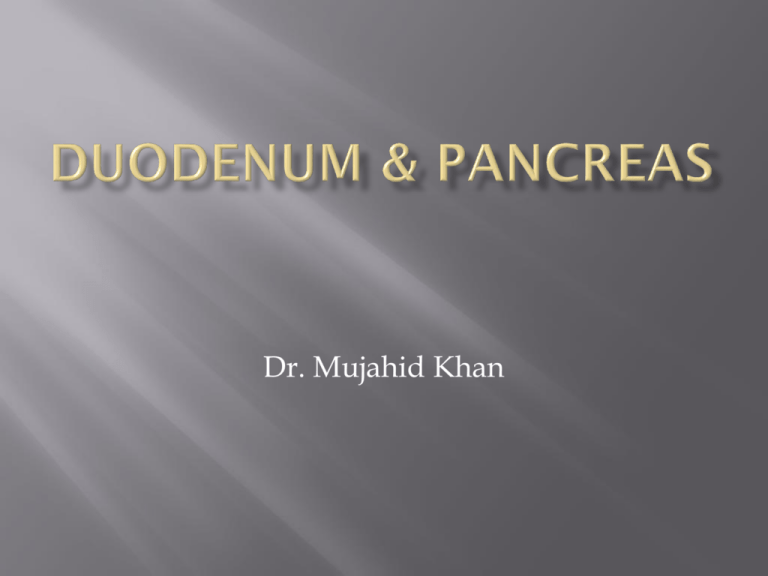
Dr. Mujahid Khan It is a “C” shaped tube About 10 inches (25 cm) long It joins the stomach to the jejunum It receives openings of bile and pancreatic ducts Curves around the head of the pancreas First inch of duodenum resembles stomach as its anterior and posterior surfaces are also covered with peritoneum Lesser omentum attached to its upper border Greater omentum attached to its lower border Remainder of the duodenum is retroperitoneal, only partially covered by peritoneum Is divided into four parts for the purpose of description It is 2 inches (5 cm) long and begins at pylorus Situated in the epigastric and umbilical regions Lies on the transpyloric plane Anteriorly: Quadrate lobe of the liver and gall bladder Posteriorly: The lesser sac, gastroduodenal artery, bile duct, portal vein and IVC Superiorly: The entrance into the lesser sac Inferiorly: Head of the pancreas Is 3 inches (8 cm) long and runs vertically downward in front of the hilum of the right kidney Halfway down its medial border, the bile duct and main pancreatic duct pierce the duodenal wall by major duodenal papilla The accessory pancreatic duct if present, opens a little higher up on the minor duodenal papilla Anteriorly: The fundus of gall bladder, right lobe of liver, and the transverse colon Posteriorly: Hilum of the right kidney and the right ureter Laterally: Ascending colon, right colic flexure, and the right lobe of the liver Medially: Head of the pancreas, bile duct, and the main pancreatic duct Is 3 inches (8 cm) long Runs horizontally to the left on the subcostal plane Passing in front of the vertebral column Following the lower margin of the head of the pancreas Anteriorly: The root of mesentery of small intestine, superior mesenteric vessels Posteriorly: The right ureter, right psoas muscle, IVC, and the aorta Superiorly: Head of the pancreas Inferiorly: Coils of jejunum Is 2 inches (5 cm) long Runs upward and to the left of the duodenojejunal flexure The flexure is held in position by a peritoneal fold, ligamentum treitz Anteriorly: The beginning of the root of the mesentery and coils of jejunum Posteriorly: The left margin of aorta, and the medial border of the left psoas muscle Is thick and smooth in the first part In the remainder parts is thrown into numerous circular folds called plicae circulares The upper half is supplied by superior pancreaticoduodenal artery, a branch of gastroduodenal artery The lower half is supplied by the inferior pancreaticoduodenal artery, a branch of the superior mesenteric artery The pancreas is both an exocrine and an endocrine gland Produces a secretion that hydrolyzes the carbohydrates, proteins and fats The endocrine portion of the gland is islets of langerhans produces insulin and glucagon hormones These hormones play a key role in carbohydrate metabolism It is an elongated structure Lies in the epigastrium and left upper quadrant It is soft and lobulated, situated on the posterior abdominal wall behind the peritoneum It is divided into head, neck, body and tail Head: Is a disc shaped and lies within the concavity of the duodenum, has a process behind the superior mesenteric vessels called uncinate process Neck: Is the constricted portion, connects the head to the body, lies in front of the origin of the superior mesenteric artery from the aorta Body: Runs upward and to the left across the midline and is somewhat triangular in cross section Tail: Passes forward in the splenicorenal ligament and comes in contact with the hilum of the spleen Anteriorly: Transverse colon and the attachment of the transverse mesocolon, the lesser sac and the stomach Posteriorly: Bile duct, the portal and splenic veins, IVC, the aorta, the origin of superior mesenteric artery, the left suprarenal gland, the left kidney, and the hilum of the spleen The main duct of the pancreas begins in the tail Runs the length of the gland, receiving numerous tributaries Opens into the second part of the duodenum with the bile duct on the major duodenal papilla Sometimes the main duct drains separately into the duodenum The accessory duct, if present, drains the upper part of the head Opens a little above the main duct on the minor duodenal papilla The accessory duct frequently communicates with the main duct Arteries: The superior and inferior pancreaticoduodenal arteries Veins: The corresponding veins drain into the portal vein
